The Playing And Notation of The Right Hand - 2
Click the pictures for bigger image or video.
|
|
 |
Notation:
Name: Muǒ Tiaǒ 抹挑
Explanation: The combination of Muǒ and Tiaǒ, the index finger plucks the string first then strums. |
|
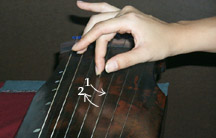 |
Notation:
Name: Gou Ti 勾剔
Explanation: The combination of Gou and Ti, the middle finger plucks the string first then strums. |
|
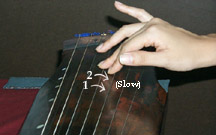 |
Notation:
Name: Muǒ Gou 抹勾
Explanation: The combination of Muǒ and Gou, on the same string, do Muǒ first then Gou, it creates 2 gradually continuing sounds. See video of Dié Juan 疊蠲(涓).
|
|
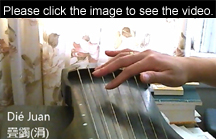 |
Notation:
Name: Dié Juan 疊蠲(涓)
Explanation: Same as Muǒ Gou but faster. |
|
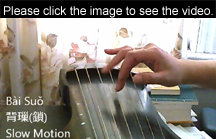 |
Notation:
Name: Bài Suǒ 背璅(鎖)
Explanation: On the same string, use Ti Muǒ Tiaǒ to play a fast continuing 3 sounds. Use the tip of the nails, don't put them too deep into the string.
|
|
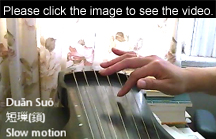 |
Notation:
Name: Duăn Suǒ 短璅(鎖)
Explanation: On the same string, do Muǒ Gou first, a slowly and gradually continuing sound, then following with Ti Muǒ Tiaǒ, a faster continuing sound.
|
|
 |
Notation:
Name: Cháng Suǒ 長鎻(璅)
Explanation: On the same string, do the Muǒ Tiaǒ, Muǒ Gou 4 sound first then follow with the Tì Muǒ Tiaǒ 3 continuing sound.
|
|
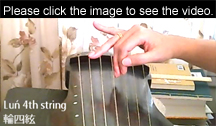 |
Notation:
Name: Luń 輪
Explanation: On the same string, use the ring finger, middle finger and index finger to do Zhai, Ti, Tiaǒ 3 continuing sound.
When playing this technique, bend the 3 fingers slightly, then strum the string gradually. Try to make it strong and clear.
|
|
 |
Notation:
Name: Bàn Luń (half Luń) 半輪
Explanation: Same technique as Luń but one sound less than Luń. On the same string, use either Zhai Ti or Ti Tiaǒ.
|
|
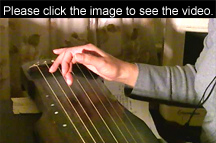 |
Notation: (or 口一) (or 口一)
Name: Rú Yi 如一
Explanation: Rú Yi literally means "as one." When there are 2 strings that can be created an Àn Yin and a Săn Yin with the same sound at one time, use the middle finger or index finger (usually use the middle finger) to strum the 2 strings together.
|
|
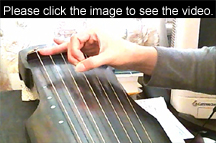 |
Notation:
Name: Shuang Tán 雙彈
Explanation: Same as Rú Yi but play twice. Before strumming the string, position the index and middle finger above the thumb, do Ti then Tiaǒ.
Some tablature will indicate a "Shuang Tán" follow by a "Rú Yi," which reminds the player that making the two previous sound as one sound.
|
|